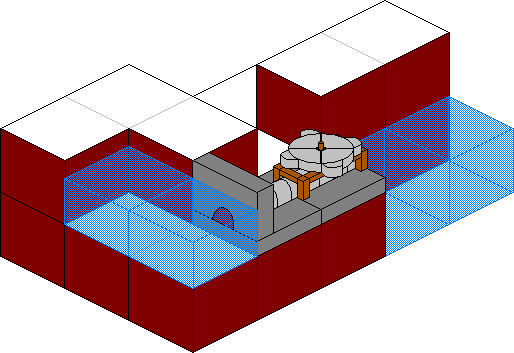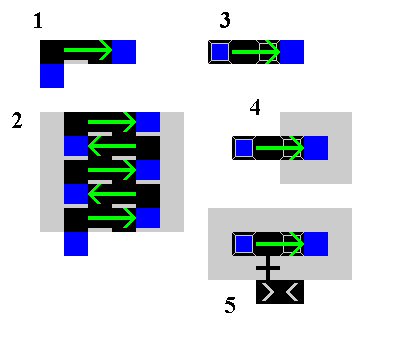- v50 information can now be added to pages in the main namespace. v0.47 information can still be found in the DF2014 namespace. See here for more details on the new versioning policy.
- Use this page to report any issues related to the migration.
40d:Screw pump
|
b-M-s | |||||||
| |||||||
| Job Requirement | |||||||
|---|---|---|---|---|---|---|---|
| Construction | |||||||
| Materials | Jobs | ||||||
| |||||||
| Power | |||||||
|
Needs 10 power. | |||||||
A screw pump can lift water from below onto the same Z-level as the pump. It is two tiles by one tile in size, and it can be either manually operated by a dwarf with the pump operator job or by using gear assemblies connected to water wheels and/or windmills. The direction you want the water to travel must be chosen at the time of construction.
Construction
Building a screw pump requires an enormous corkscrew, a stone, wood, or glass block, and a pipe section. The light green X must be next to the water source and the dark green X is where the water exits the pump. Having specified the direction of travel, you must ensure that the source side of the pump is placed adjacent to and above (in the z-axis) a liquid. The screw pump will draw the liquid up from below, and distribute it out of the other side of the pump. Screw pumps are buildings that can be removed to recover the materials.
Notes
- The source of the pump must be directionally adjacent to "Open Space" that is directly above a filled pool of liquid. The adjacent space cannot be a floor, hatch, or wall suspended over water. Screw pumps can pump water through a grate or floor bars.
- In order to build pumps in a "hanging" state, as in the stacked screw pump example, the dark tile of the screw pump must be able to connect to a nearby machine; either already existing or designated to be built.
- The rear pump tile does not block creature movement. The front of the pump does block creature movement.
- The front pump tile blocks water flow. The rear of the pump does not block water flow.
- Dwarves must be able to access and stand on the rear tile of the pump in order to be able to operate the pump manually.
- Active mechanisms connected to the pump will automatically start the pump; to prevent this either restrict water flow using floodgates, or put in a gear assembly linked to a lever to disconnect motion.
- Pumps can also be used in conjunction with a water wheel or a windmill to become self-powered.
- Pumps can not push water up additional Z-levels. That is, if you direct the output of a screw pump into a 1-square space surrounded by walls, the water will not "overflow" the walls.
- Consequently, a pump will refuse to move water if the level it is pumping to is completely filled.
Example layouts
Single Pump
Multiple Levels
Stacked pumps
See Diagram 2. This example is from a Bay12 forum thread.
- Side view of the basic pump unit. Water is moved from the lower floor to the upper; notice how the front of the pump does not need a floor.
- Side view of stacked screw pumps. Power is transmitted vertically through the missing floor tiles under the fronts of the pumps - no need for gearboxes in this design. The screw pump front prevents the water from flowing diagonally downwards.
- Top view of the basic pump unit.
- Top view with walls in place to prevent the receiving area from spilling out. If this is all it needed, these units could be stacked on top of each other, but it's missing one thing - dwarf access. There's no stairs/ramps, and no good place to put them either that wouldn't interfere with the adjacent levels' water containment.
- Solution for a freestanding tower - fire escape! Sure, you could consolidate the up and downstairs into a single up/down stair tile, but I like the zigzag and symmetrical arrangement this one presents. Just build these on top of each other, flipping horizontally each time, and bam. Minimal yet aesthetic multi-level water pumping.
L-shaped Tunnels
I use this system in conjunction with a river to power the water wheels.
I wanted to be able to pump water up several levels without wasting dwarves on "Pumping". So by using a system of water wheels and gears, and a bit of trial and error until I fixed my leaking problems, I came up with the following solution, where the "1st" and "2nd" levels simply alternate until I reach the desired height.
Digging Plan: Level 1 Level 2 Key ######## ######## # Undug wall ######## # ## X Up/down staircase ######## # ### ## _ Channel #X# # #X# _# # # #### ### # ## # _## ### #_## ###_#### ### #### ######## ########
Building Plan Level 1 Level 2 Key ######## ######## % Screw pump ######## # ## * Gear ######## # ### ## #X# # #X# %%_# # #%#### ### #*## # %**## ### #*## ###_#### ### #### ######## ########
The red gear transmits power vertically, while the other ones give power to the pumps. Switching from up to left (or down to right, the orientation of the L doesn't matter) stops water leaking back down the vertical shaft. A single water wheel provides enough power for about 4 storeys. You will, of course, want to insert floodgates with levers at various locations. Attaching the gears that power the pumps to levers will allow you to turn the system off safely if needed.
Hooking up to 2 water wheels Key ############ = Wooden axle (E/W) #X# #### | Wooden axle (N/S) # # ######## H Water wheel # %***==*## . Channel where water is flowing ###%##|##|## ###..HHHHHH. ############
A problem occurs when as the channel fills - as soon as it's deep enough for the wheels to spin the machine activates, sucking water out of the channel and making it too shallow for the wheels to spin, leading to a distinct 'stop-start' behaviour. It just takes time to even out - I suggest filling the channel before starting on the rest of the tower.
Space-saving L-shaped Tunnels
This design is more compact than the water tower design above, but the absence of the extra gears means that you can't connect the pumps to an "off" lever without having the whole structure collapse when the lever is pulled and the gears are disengaged.
The L-shape's purpose is to stop water leaking back down the system. Note that either level may be used as the base and tessellated appropriately.
Phase I - Dig out the basic shape of the structure
Digging Level 1 Level 2 Key ###### ###### # Undug wall # # # _# . May be wall, cleared, or stairs. # #### # # ## _ Channel # .. # # .. #_#... # #... ###... ###...
Phase II - Construct the screw pumps and driver gears.
Construction Level 1 Level 2 Key ###### ###### % Output side of pump # # # %%_# % Input side of pump #%#### # #*## * Direct drive gears #%* .. # # .. #_#... # #... ###... ###...
Phase III - Dig out the vertical channel for the power transfer column.
Digging Level 1 Level 2 Key ###### ###### _ Channel for transfer gear. # # # %%_# #%#### # #*## #%*_.. # #_.. #_#... # #... ###... ###...
Phase IV - Finally place the power transfer gear:
Construction Level 1 Level 2 Key ###### ###### ˜ Water on z-1 #≈≈≈≈# #≈%%˜# ≈ Water on current z #%#### #≈#*## * Power Transfer Gear #%**.. #≈#*.. #˜#... #≈#... ###... ###...
Running a pump with a windmill
First, build a windmill anywhere aboveground (note that it won't do anything yet).
Then, build the pump. The end you selected to 'pump from' will suck water up from the level below, then pump it out of the other end. Build with this in mind. If you want to pump from a river, the 'pump from' end should be on the river.
Both the pipe and corkscrew can be built by a carpenter, (the corkscrew is listed as something like 'enormous wooden cor' if you are using the single-width screen, but hitting Tab to expand the screen should reveal the full text).
Connecting windmills to pumps:
Note that it's much easier if the centre of the windmill lines up with the pump.
- Dig one level below the windmill and put a gear assembly directly beneath the axle (at centre of windmill). The windmill will start turning.
- You're probably going to want to bring your power up to the surface. To do this, dig away from the first gear until the surface is clear above. Place another gear here.
- Connect the gears together using a horizontal axle.
- Get a miner to channel on top of the second gear.
- Build a third gear in this channel. You should now have a turning gear on the surface.
- If you thought ahead, you should only need one axle to connect the surface gear to the pump. A pump can be powered from any side.
I recommend that you connect a lever to one of your gears beforehand. The pump will start pumping as soon as it has power.
You can change stuff around as the situation dictates, but that should get you started.
The pictures aren't lined up - the far right gear in the second picture is the one below the surface gear.
Alternate Uses
Pumps can also be built with no actual pumping in mind but as dwarven exercise machines. This is an excellent method to train haulers for better strength and agility or for future soldiers.
Screw pumps also act to desalinate any water which is pumped through them. This is very useful for providing a source of potable water in otherwise entirely salt-water regions.
External links
- DFMA Ingame Videos featuring screw pumps: (Movies with Pump in the title)



